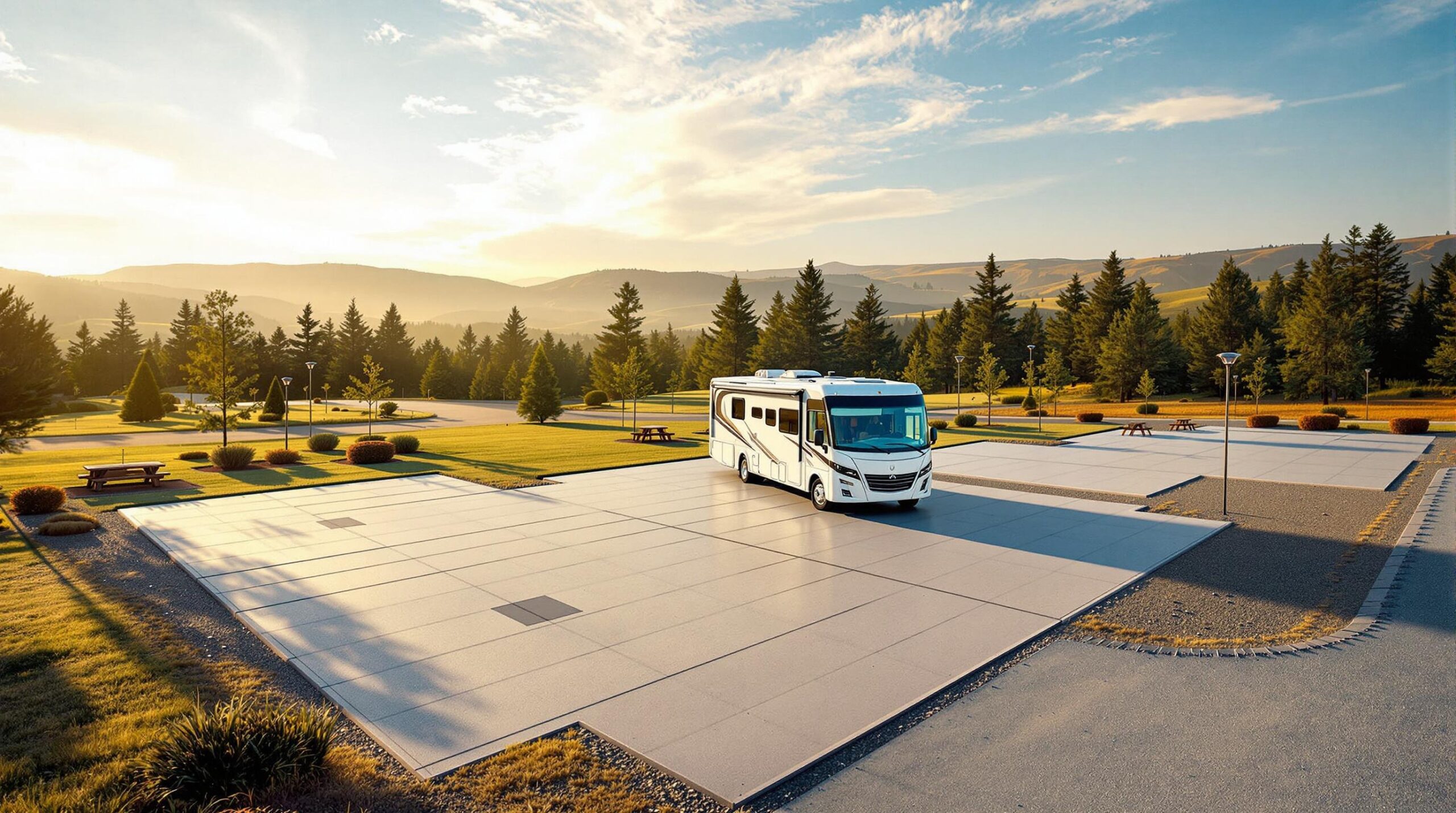Montana is rolling out public and private RV pads engineered for longer Class A coaches—often topping 40 feet, the high end of the motorhome spectrum, though the average Class A is closer to 33 feet—giving the state’s outdoor‐hospitality sector a fresh reason to pour more concrete and pull heavier wire. Three projects—at Makoshika State Park, at Montana Basecamp in Kalispell and at the soon-to-open Pipestone RV Park—show how demand for large-rig sites is reshaping everything from environmental cleanup plans to amenity mixes.
Rigs keep getting longer, guests want instant hookups and streaming-grade Wi-Fi, and big-rig-friendly parks across the Treasure State routinely hit 100 percent occupancy in midsummer. Pads capable of hosting Class A coaches often book early each July and August, according to park managers. Here’s how three very different sites are scaling up to meet that demand.
Montana Fish, Wildlife & Parks wants to convert a former 37,500-square-foot shooting range at Makoshika State Park near Glendive into 16 full-service RV pads with electric hookups, a $3.4 million to $4.4 million undertaking that includes excavating roughly 1,750 cubic yards of lead-contaminated soil and hauling it to a certified disposal site, according to state filing. “The project design has not been finalized as we are currently accepting public comments which may alter the project,” Brian Burky, Region 7 park manager, said in an email. “That being said, the project concept is estimated to cost between $3.4 million and $4.4 million.”
Crews will follow a playbook many private operators now use: commission Phase I and II environmental assessments, backfill with engineered soils that support native vegetation, tuck bioswales beside parking loops and specify full-cutoff warm LEDs to protect dark skies. Those sustainable touches become marketing assets once the 16 new pads open, tentatively in 2026 after a construction season slated for 2025. A dinosaur-themed playground and several new hike-and-bike sites are also planned to widen the park’s family appeal.
About 450 miles northwest of Makoshika State Park, Kalispell’s Montana Basecamp is already catering to Class A owners. Sitting on a former 50-acre dairy farm, the resort has entitlements for 330 sites and opened its first 62 in June 2019, each measuring 35 by 100 feet and configured as back-ins for safety, according to a local report. “Montana Basecamp has the opportunity to take a 50-acre dairy farm and transform it into one of the best RV parks in America,” co-owner Andy Matthews said during a site tour. “We’re hoping to be a concierge for the city.”
Developers studying Montana Basecamp’s layout can borrow several design cues that accommodate the needs of today’s larger and more technologically advanced RVs. Interior roads should be built to 24 feet for two-way traffic and 12 feet for one-way loops, providing enough swing room for 45-foot Class A coaches towing a vehicle. Pads should be stretched to 70 to 90 feet and made of concrete or compacted asphalt to tolerate the weight of tag-axle rigs. A 96-foot inside turning radius at intersections is recommended to prevent turf damage and reduce the risk of mirror-to-mirror incidents. Utilities should be stubbed on the driver’s side, 12 to 15 feet from the rear of the pad, with 50/30/20-amp power, 100 psi water, and oversized sewer drops to accommodate residential-style dump systems. Bringing fiber or high-bandwidth cable to every pedestal is now considered essential as streaming TV and remote work have become non-negotiable for many guests. Future-proofing by running conduit for Level-2 EV chargers, even if installation is deferred, is also advised as EV “toads” behind diesel pushers are appearing more frequently.
Local planners say the project beat long odds. “Though you can’t find an RV space in the summer here, it’s a market that no one’s been able to get into,” Kalispell planning director Tom Jentz said. “It is hard to get RV parks approved because of neighborhood opposition and access to utilities.” Basecamp cleared that hurdle, and its $109 nightly rate (2019) plus direct access to the Great Northern Historical Trail and 125 fall fiesta maples position the park at the high end of Montana’s RV spectrum.
About an hour east of Butte, the privately funded Pipestone RV Park expects to welcome its first guests in September 2024 with 80 full-hookup RV sites and 31 cabin or tent spots, complete with a check-in center, general store, lounge, three shower houses and roughly 20 bathrooms, according to a developer summary. “What makes Pipestone so special is its unique rock formations,” developer Keith Curtis said during a site walk. “You have the ringing rocks. Then you have areas like the Flintstone house. And you have Delmoe Lake up here too, so you have some bodies of water. And not to mention a huge network of trails.”
Because the park is still hammering out punch lists, managers can layer in dark-sky lighting, solar carport canopies and low-flow fixtures now—moves that cut utility bills and let marketers tout an eco-friendly brand from day one.
Statewide numbers point to more upside. Makoshika drew 112,000 visitors in 2021 and expects lodging-tax collections to jump nearly 80 percent—about $6,500 collected in FY 2024 versus an expected additional $5,100 once the new sites open—even as Jentz warns that “you can’t find an RV space in the summer here.” For developers, the math suggests a persistent gap between supply and demand.
Meanwhile, service expectations keep climbing. Some operators report more EV-powered tow cars showing up at check-in. Guests are increasingly asking for fiber speeds to stream games and ever-wider slide-outs. Level-2 chargers at every loop may soon be standard issue. For operators willing to pour concrete to Class A specs and wire pedestals for streaming speeds, the pad counts, visitation growth and new tax revenue suggest Montana’s RV boom has room to grow.
From badlands fossils to high-desert boulders, big-rig travelers could soon roll into Montana with room to spare—and hookups ready to go.


